Case Study: Analyzing Management, People, and Teams at CST
VerifiedAdded on 2023/01/19
|15
|4197
|27
Case Study
AI Summary
This case study examines CST, a multinational corporation facing significant challenges in its defense system operations. The case study explores issues such as declining market share, loss of key contracts, employee retention problems, and technological inadequacies. The report delves into the importance of effective human resource management, team development, and performance management, highlighting the need for CST to address these issues to improve its brand reputation and competitiveness. It analyzes the impact of staff turnover, the resignation of key specialists, and the need for technological advancements to enhance the company's capabilities. The study provides recommendations for attracting and retaining talent, fostering team development, implementing effective performance management strategies, and managing change within the organization to overcome these challenges and achieve its strategic goals.
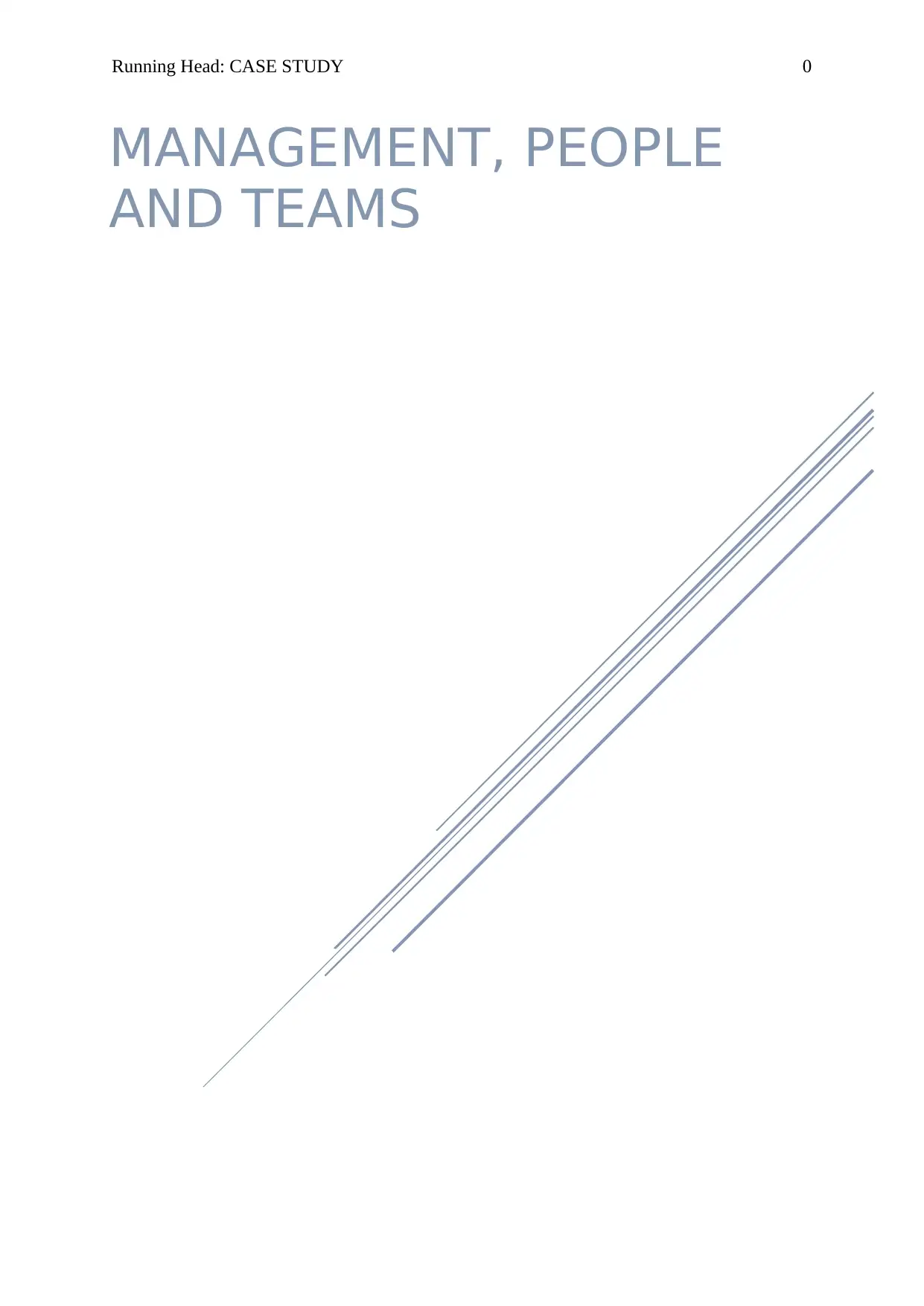
Running Head: CASE STUDY 0
MANAGEMENT, PEOPLE
AND TEAMS
MANAGEMENT, PEOPLE
AND TEAMS
Paraphrase This Document
Need a fresh take? Get an instant paraphrase of this document with our AI Paraphraser
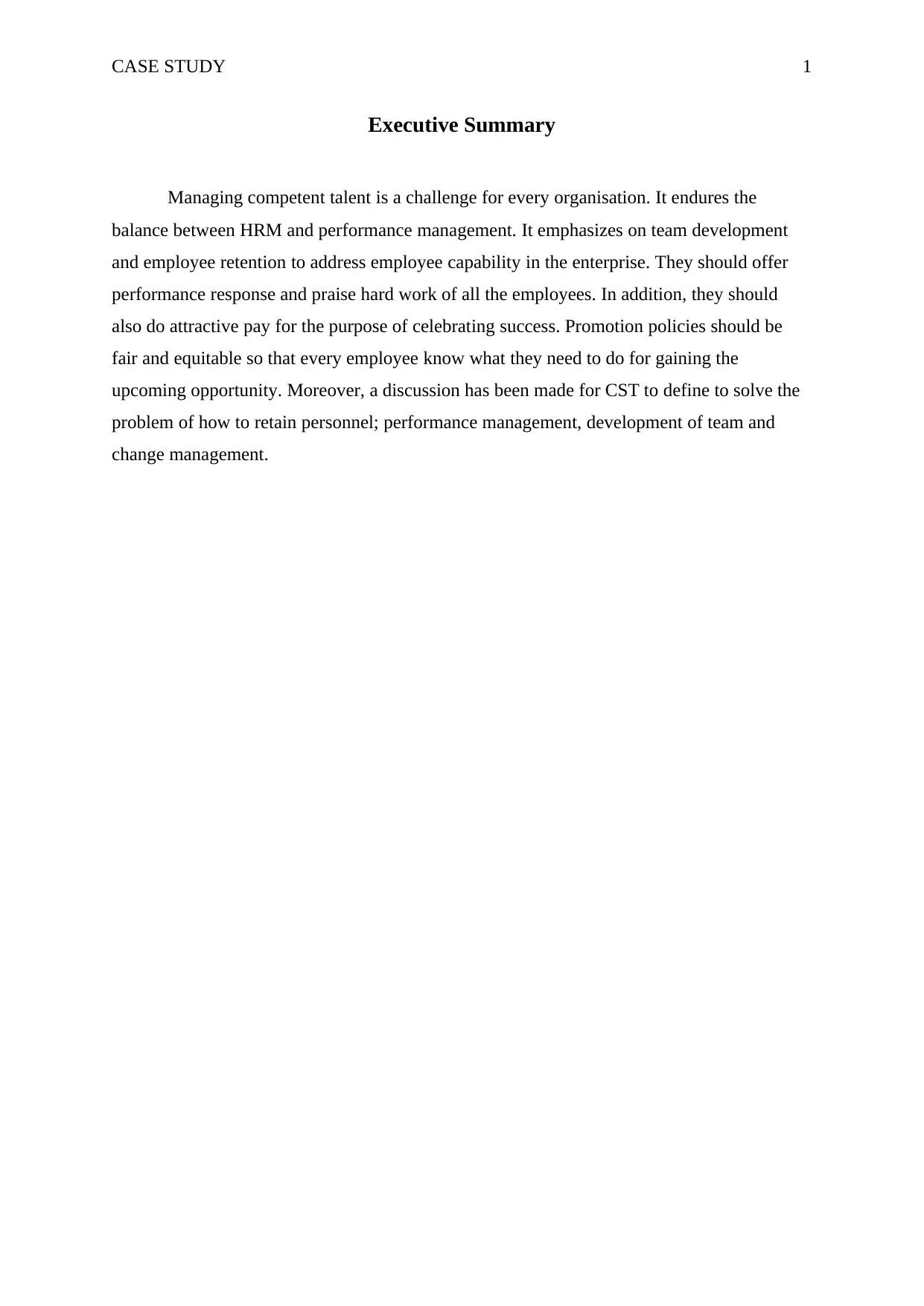
CASE STUDY 1
Executive Summary
Managing competent talent is a challenge for every organisation. It endures the
balance between HRM and performance management. It emphasizes on team development
and employee retention to address employee capability in the enterprise. They should offer
performance response and praise hard work of all the employees. In addition, they should
also do attractive pay for the purpose of celebrating success. Promotion policies should be
fair and equitable so that every employee know what they need to do for gaining the
upcoming opportunity. Moreover, a discussion has been made for CST to define to solve the
problem of how to retain personnel; performance management, development of team and
change management.
Executive Summary
Managing competent talent is a challenge for every organisation. It endures the
balance between HRM and performance management. It emphasizes on team development
and employee retention to address employee capability in the enterprise. They should offer
performance response and praise hard work of all the employees. In addition, they should
also do attractive pay for the purpose of celebrating success. Promotion policies should be
fair and equitable so that every employee know what they need to do for gaining the
upcoming opportunity. Moreover, a discussion has been made for CST to define to solve the
problem of how to retain personnel; performance management, development of team and
change management.
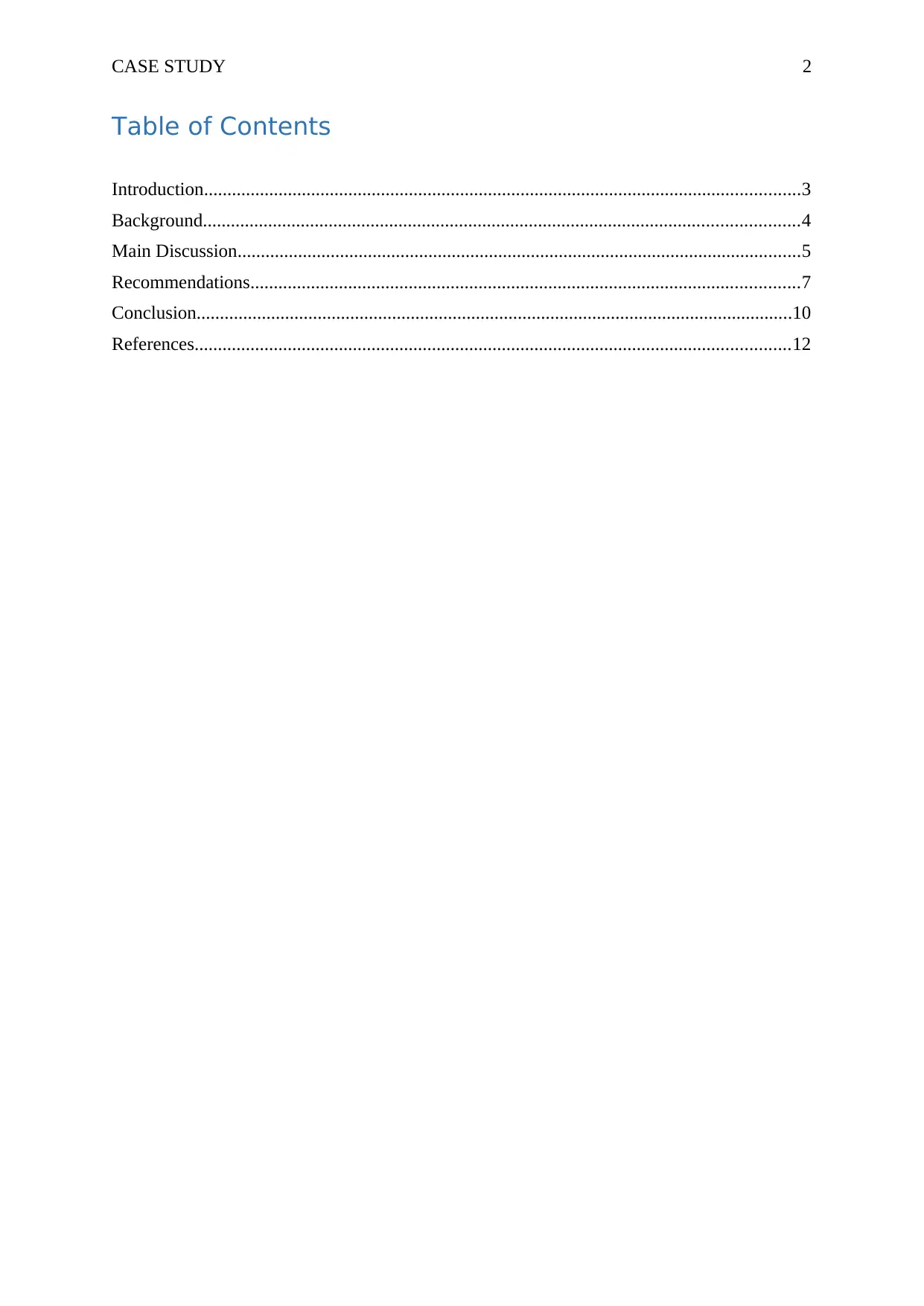
CASE STUDY 2
Table of Contents
Introduction................................................................................................................................3
Background................................................................................................................................4
Main Discussion.........................................................................................................................5
Recommendations......................................................................................................................7
Conclusion................................................................................................................................10
References................................................................................................................................12
Table of Contents
Introduction................................................................................................................................3
Background................................................................................................................................4
Main Discussion.........................................................................................................................5
Recommendations......................................................................................................................7
Conclusion................................................................................................................................10
References................................................................................................................................12
⊘ This is a preview!⊘
Do you want full access?
Subscribe today to unlock all pages.

Trusted by 1+ million students worldwide
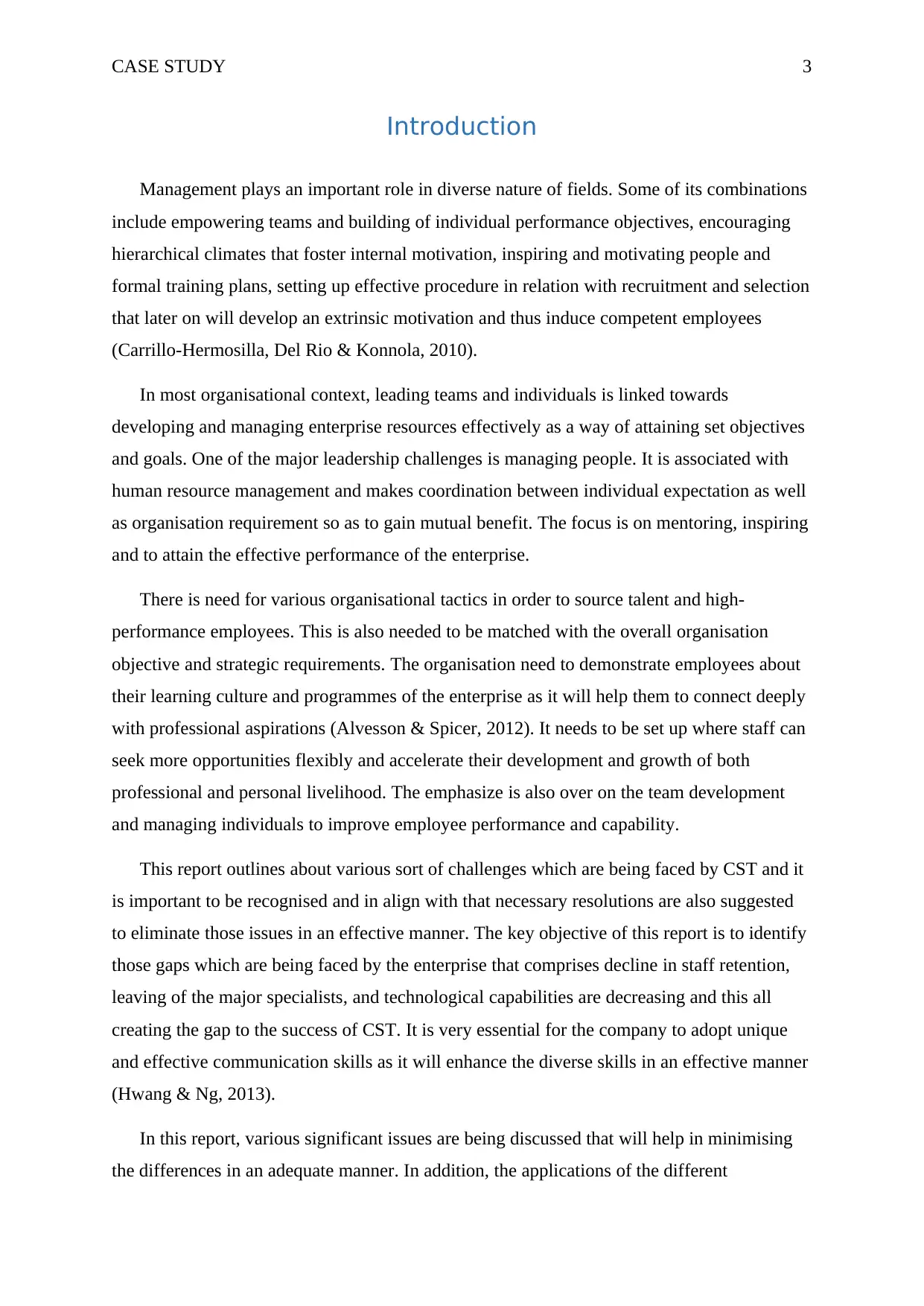
CASE STUDY 3
Introduction
Management plays an important role in diverse nature of fields. Some of its combinations
include empowering teams and building of individual performance objectives, encouraging
hierarchical climates that foster internal motivation, inspiring and motivating people and
formal training plans, setting up effective procedure in relation with recruitment and selection
that later on will develop an extrinsic motivation and thus induce competent employees
(Carrillo-Hermosilla, Del Rio & Konnola, 2010).
In most organisational context, leading teams and individuals is linked towards
developing and managing enterprise resources effectively as a way of attaining set objectives
and goals. One of the major leadership challenges is managing people. It is associated with
human resource management and makes coordination between individual expectation as well
as organisation requirement so as to gain mutual benefit. The focus is on mentoring, inspiring
and to attain the effective performance of the enterprise.
There is need for various organisational tactics in order to source talent and high-
performance employees. This is also needed to be matched with the overall organisation
objective and strategic requirements. The organisation need to demonstrate employees about
their learning culture and programmes of the enterprise as it will help them to connect deeply
with professional aspirations (Alvesson & Spicer, 2012). It needs to be set up where staff can
seek more opportunities flexibly and accelerate their development and growth of both
professional and personal livelihood. The emphasize is also over on the team development
and managing individuals to improve employee performance and capability.
This report outlines about various sort of challenges which are being faced by CST and it
is important to be recognised and in align with that necessary resolutions are also suggested
to eliminate those issues in an effective manner. The key objective of this report is to identify
those gaps which are being faced by the enterprise that comprises decline in staff retention,
leaving of the major specialists, and technological capabilities are decreasing and this all
creating the gap to the success of CST. It is very essential for the company to adopt unique
and effective communication skills as it will enhance the diverse skills in an effective manner
(Hwang & Ng, 2013).
In this report, various significant issues are being discussed that will help in minimising
the differences in an adequate manner. In addition, the applications of the different
Introduction
Management plays an important role in diverse nature of fields. Some of its combinations
include empowering teams and building of individual performance objectives, encouraging
hierarchical climates that foster internal motivation, inspiring and motivating people and
formal training plans, setting up effective procedure in relation with recruitment and selection
that later on will develop an extrinsic motivation and thus induce competent employees
(Carrillo-Hermosilla, Del Rio & Konnola, 2010).
In most organisational context, leading teams and individuals is linked towards
developing and managing enterprise resources effectively as a way of attaining set objectives
and goals. One of the major leadership challenges is managing people. It is associated with
human resource management and makes coordination between individual expectation as well
as organisation requirement so as to gain mutual benefit. The focus is on mentoring, inspiring
and to attain the effective performance of the enterprise.
There is need for various organisational tactics in order to source talent and high-
performance employees. This is also needed to be matched with the overall organisation
objective and strategic requirements. The organisation need to demonstrate employees about
their learning culture and programmes of the enterprise as it will help them to connect deeply
with professional aspirations (Alvesson & Spicer, 2012). It needs to be set up where staff can
seek more opportunities flexibly and accelerate their development and growth of both
professional and personal livelihood. The emphasize is also over on the team development
and managing individuals to improve employee performance and capability.
This report outlines about various sort of challenges which are being faced by CST and it
is important to be recognised and in align with that necessary resolutions are also suggested
to eliminate those issues in an effective manner. The key objective of this report is to identify
those gaps which are being faced by the enterprise that comprises decline in staff retention,
leaving of the major specialists, and technological capabilities are decreasing and this all
creating the gap to the success of CST. It is very essential for the company to adopt unique
and effective communication skills as it will enhance the diverse skills in an effective manner
(Hwang & Ng, 2013).
In this report, various significant issues are being discussed that will help in minimising
the differences in an adequate manner. In addition, the applications of the different
Paraphrase This Document
Need a fresh take? Get an instant paraphrase of this document with our AI Paraphraser
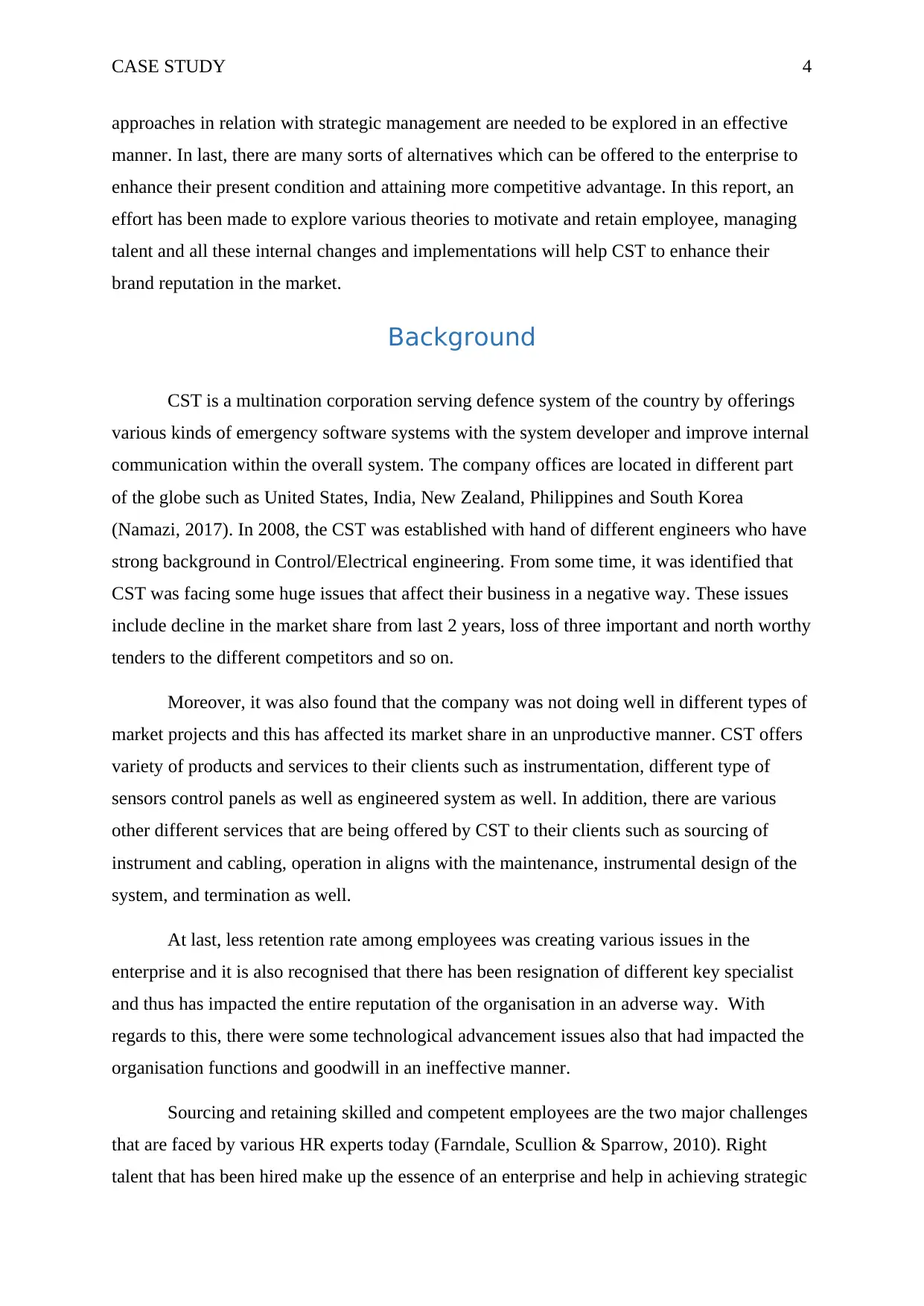
CASE STUDY 4
approaches in relation with strategic management are needed to be explored in an effective
manner. In last, there are many sorts of alternatives which can be offered to the enterprise to
enhance their present condition and attaining more competitive advantage. In this report, an
effort has been made to explore various theories to motivate and retain employee, managing
talent and all these internal changes and implementations will help CST to enhance their
brand reputation in the market.
Background
CST is a multination corporation serving defence system of the country by offerings
various kinds of emergency software systems with the system developer and improve internal
communication within the overall system. The company offices are located in different part
of the globe such as United States, India, New Zealand, Philippines and South Korea
(Namazi, 2017). In 2008, the CST was established with hand of different engineers who have
strong background in Control/Electrical engineering. From some time, it was identified that
CST was facing some huge issues that affect their business in a negative way. These issues
include decline in the market share from last 2 years, loss of three important and north worthy
tenders to the different competitors and so on.
Moreover, it was also found that the company was not doing well in different types of
market projects and this has affected its market share in an unproductive manner. CST offers
variety of products and services to their clients such as instrumentation, different type of
sensors control panels as well as engineered system as well. In addition, there are various
other different services that are being offered by CST to their clients such as sourcing of
instrument and cabling, operation in aligns with the maintenance, instrumental design of the
system, and termination as well.
At last, less retention rate among employees was creating various issues in the
enterprise and it is also recognised that there has been resignation of different key specialist
and thus has impacted the entire reputation of the organisation in an adverse way. With
regards to this, there were some technological advancement issues also that had impacted the
organisation functions and goodwill in an ineffective manner.
Sourcing and retaining skilled and competent employees are the two major challenges
that are faced by various HR experts today (Farndale, Scullion & Sparrow, 2010). Right
talent that has been hired make up the essence of an enterprise and help in achieving strategic
approaches in relation with strategic management are needed to be explored in an effective
manner. In last, there are many sorts of alternatives which can be offered to the enterprise to
enhance their present condition and attaining more competitive advantage. In this report, an
effort has been made to explore various theories to motivate and retain employee, managing
talent and all these internal changes and implementations will help CST to enhance their
brand reputation in the market.
Background
CST is a multination corporation serving defence system of the country by offerings
various kinds of emergency software systems with the system developer and improve internal
communication within the overall system. The company offices are located in different part
of the globe such as United States, India, New Zealand, Philippines and South Korea
(Namazi, 2017). In 2008, the CST was established with hand of different engineers who have
strong background in Control/Electrical engineering. From some time, it was identified that
CST was facing some huge issues that affect their business in a negative way. These issues
include decline in the market share from last 2 years, loss of three important and north worthy
tenders to the different competitors and so on.
Moreover, it was also found that the company was not doing well in different types of
market projects and this has affected its market share in an unproductive manner. CST offers
variety of products and services to their clients such as instrumentation, different type of
sensors control panels as well as engineered system as well. In addition, there are various
other different services that are being offered by CST to their clients such as sourcing of
instrument and cabling, operation in aligns with the maintenance, instrumental design of the
system, and termination as well.
At last, less retention rate among employees was creating various issues in the
enterprise and it is also recognised that there has been resignation of different key specialist
and thus has impacted the entire reputation of the organisation in an adverse way. With
regards to this, there were some technological advancement issues also that had impacted the
organisation functions and goodwill in an ineffective manner.
Sourcing and retaining skilled and competent employees are the two major challenges
that are faced by various HR experts today (Farndale, Scullion & Sparrow, 2010). Right
talent that has been hired make up the essence of an enterprise and help in achieving strategic
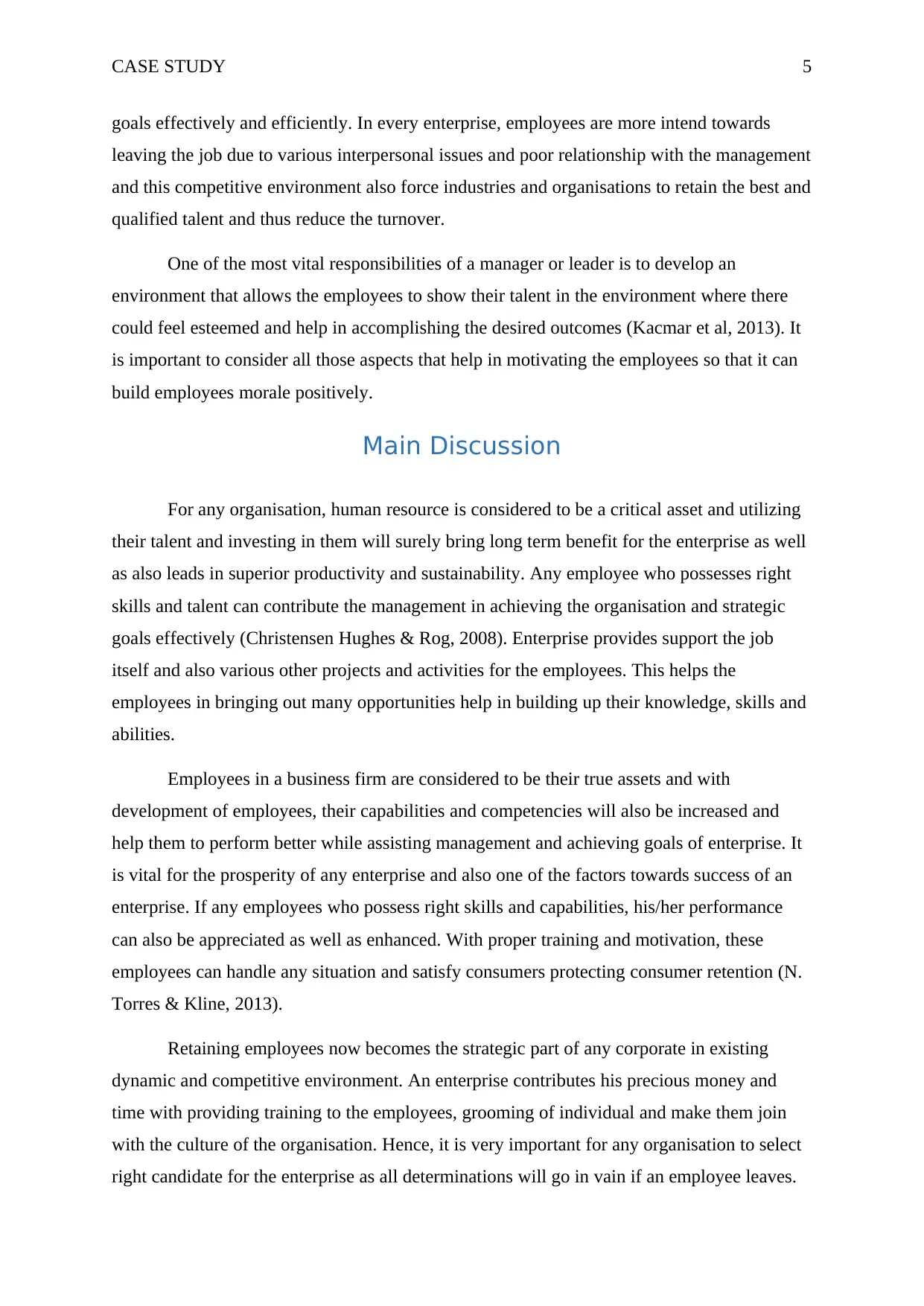
CASE STUDY 5
goals effectively and efficiently. In every enterprise, employees are more intend towards
leaving the job due to various interpersonal issues and poor relationship with the management
and this competitive environment also force industries and organisations to retain the best and
qualified talent and thus reduce the turnover.
One of the most vital responsibilities of a manager or leader is to develop an
environment that allows the employees to show their talent in the environment where there
could feel esteemed and help in accomplishing the desired outcomes (Kacmar et al, 2013). It
is important to consider all those aspects that help in motivating the employees so that it can
build employees morale positively.
Main Discussion
For any organisation, human resource is considered to be a critical asset and utilizing
their talent and investing in them will surely bring long term benefit for the enterprise as well
as also leads in superior productivity and sustainability. Any employee who possesses right
skills and talent can contribute the management in achieving the organisation and strategic
goals effectively (Christensen Hughes & Rog, 2008). Enterprise provides support the job
itself and also various other projects and activities for the employees. This helps the
employees in bringing out many opportunities help in building up their knowledge, skills and
abilities.
Employees in a business firm are considered to be their true assets and with
development of employees, their capabilities and competencies will also be increased and
help them to perform better while assisting management and achieving goals of enterprise. It
is vital for the prosperity of any enterprise and also one of the factors towards success of an
enterprise. If any employees who possess right skills and capabilities, his/her performance
can also be appreciated as well as enhanced. With proper training and motivation, these
employees can handle any situation and satisfy consumers protecting consumer retention (N.
Torres & Kline, 2013).
Retaining employees now becomes the strategic part of any corporate in existing
dynamic and competitive environment. An enterprise contributes his precious money and
time with providing training to the employees, grooming of individual and make them join
with the culture of the organisation. Hence, it is very important for any organisation to select
right candidate for the enterprise as all determinations will go in vain if an employee leaves.
goals effectively and efficiently. In every enterprise, employees are more intend towards
leaving the job due to various interpersonal issues and poor relationship with the management
and this competitive environment also force industries and organisations to retain the best and
qualified talent and thus reduce the turnover.
One of the most vital responsibilities of a manager or leader is to develop an
environment that allows the employees to show their talent in the environment where there
could feel esteemed and help in accomplishing the desired outcomes (Kacmar et al, 2013). It
is important to consider all those aspects that help in motivating the employees so that it can
build employees morale positively.
Main Discussion
For any organisation, human resource is considered to be a critical asset and utilizing
their talent and investing in them will surely bring long term benefit for the enterprise as well
as also leads in superior productivity and sustainability. Any employee who possesses right
skills and talent can contribute the management in achieving the organisation and strategic
goals effectively (Christensen Hughes & Rog, 2008). Enterprise provides support the job
itself and also various other projects and activities for the employees. This helps the
employees in bringing out many opportunities help in building up their knowledge, skills and
abilities.
Employees in a business firm are considered to be their true assets and with
development of employees, their capabilities and competencies will also be increased and
help them to perform better while assisting management and achieving goals of enterprise. It
is vital for the prosperity of any enterprise and also one of the factors towards success of an
enterprise. If any employees who possess right skills and capabilities, his/her performance
can also be appreciated as well as enhanced. With proper training and motivation, these
employees can handle any situation and satisfy consumers protecting consumer retention (N.
Torres & Kline, 2013).
Retaining employees now becomes the strategic part of any corporate in existing
dynamic and competitive environment. An enterprise contributes his precious money and
time with providing training to the employees, grooming of individual and make them join
with the culture of the organisation. Hence, it is very important for any organisation to select
right candidate for the enterprise as all determinations will go in vain if an employee leaves.
⊘ This is a preview!⊘
Do you want full access?
Subscribe today to unlock all pages.

Trusted by 1+ million students worldwide
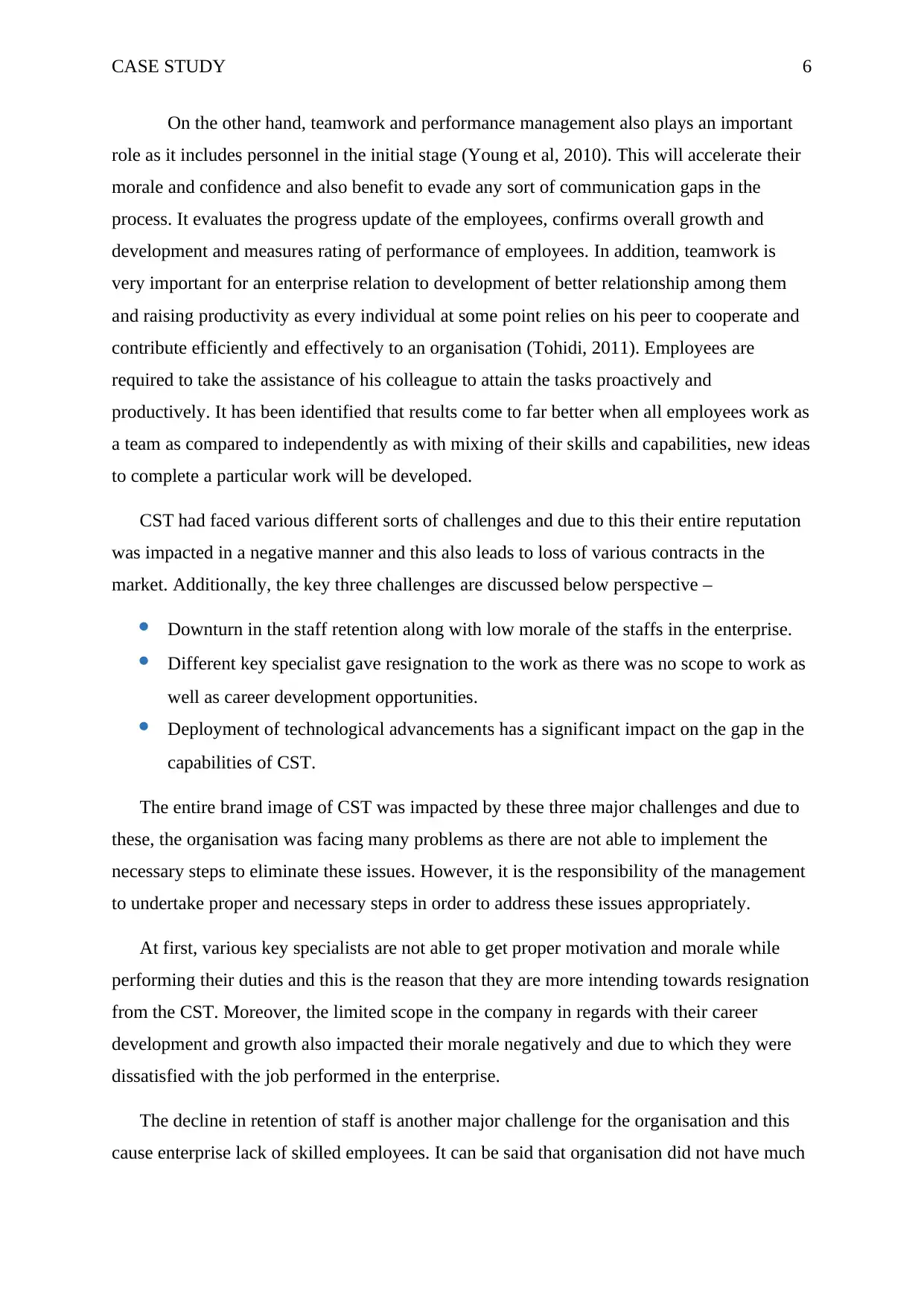
CASE STUDY 6
On the other hand, teamwork and performance management also plays an important
role as it includes personnel in the initial stage (Young et al, 2010). This will accelerate their
morale and confidence and also benefit to evade any sort of communication gaps in the
process. It evaluates the progress update of the employees, confirms overall growth and
development and measures rating of performance of employees. In addition, teamwork is
very important for an enterprise relation to development of better relationship among them
and raising productivity as every individual at some point relies on his peer to cooperate and
contribute efficiently and effectively to an organisation (Tohidi, 2011). Employees are
required to take the assistance of his colleague to attain the tasks proactively and
productively. It has been identified that results come to far better when all employees work as
a team as compared to independently as with mixing of their skills and capabilities, new ideas
to complete a particular work will be developed.
CST had faced various different sorts of challenges and due to this their entire reputation
was impacted in a negative manner and this also leads to loss of various contracts in the
market. Additionally, the key three challenges are discussed below perspective –
Downturn in the staff retention along with low morale of the staffs in the enterprise.
Different key specialist gave resignation to the work as there was no scope to work as
well as career development opportunities.
Deployment of technological advancements has a significant impact on the gap in the
capabilities of CST.
The entire brand image of CST was impacted by these three major challenges and due to
these, the organisation was facing many problems as there are not able to implement the
necessary steps to eliminate these issues. However, it is the responsibility of the management
to undertake proper and necessary steps in order to address these issues appropriately.
At first, various key specialists are not able to get proper motivation and morale while
performing their duties and this is the reason that they are more intending towards resignation
from the CST. Moreover, the limited scope in the company in regards with their career
development and growth also impacted their morale negatively and due to which they were
dissatisfied with the job performed in the enterprise.
The decline in retention of staff is another major challenge for the organisation and this
cause enterprise lack of skilled employees. It can be said that organisation did not have much
On the other hand, teamwork and performance management also plays an important
role as it includes personnel in the initial stage (Young et al, 2010). This will accelerate their
morale and confidence and also benefit to evade any sort of communication gaps in the
process. It evaluates the progress update of the employees, confirms overall growth and
development and measures rating of performance of employees. In addition, teamwork is
very important for an enterprise relation to development of better relationship among them
and raising productivity as every individual at some point relies on his peer to cooperate and
contribute efficiently and effectively to an organisation (Tohidi, 2011). Employees are
required to take the assistance of his colleague to attain the tasks proactively and
productively. It has been identified that results come to far better when all employees work as
a team as compared to independently as with mixing of their skills and capabilities, new ideas
to complete a particular work will be developed.
CST had faced various different sorts of challenges and due to this their entire reputation
was impacted in a negative manner and this also leads to loss of various contracts in the
market. Additionally, the key three challenges are discussed below perspective –
Downturn in the staff retention along with low morale of the staffs in the enterprise.
Different key specialist gave resignation to the work as there was no scope to work as
well as career development opportunities.
Deployment of technological advancements has a significant impact on the gap in the
capabilities of CST.
The entire brand image of CST was impacted by these three major challenges and due to
these, the organisation was facing many problems as there are not able to implement the
necessary steps to eliminate these issues. However, it is the responsibility of the management
to undertake proper and necessary steps in order to address these issues appropriately.
At first, various key specialists are not able to get proper motivation and morale while
performing their duties and this is the reason that they are more intending towards resignation
from the CST. Moreover, the limited scope in the company in regards with their career
development and growth also impacted their morale negatively and due to which they were
dissatisfied with the job performed in the enterprise.
The decline in retention of staff is another major challenge for the organisation and this
cause enterprise lack of skilled employees. It can be said that organisation did not have much
Paraphrase This Document
Need a fresh take? Get an instant paraphrase of this document with our AI Paraphraser
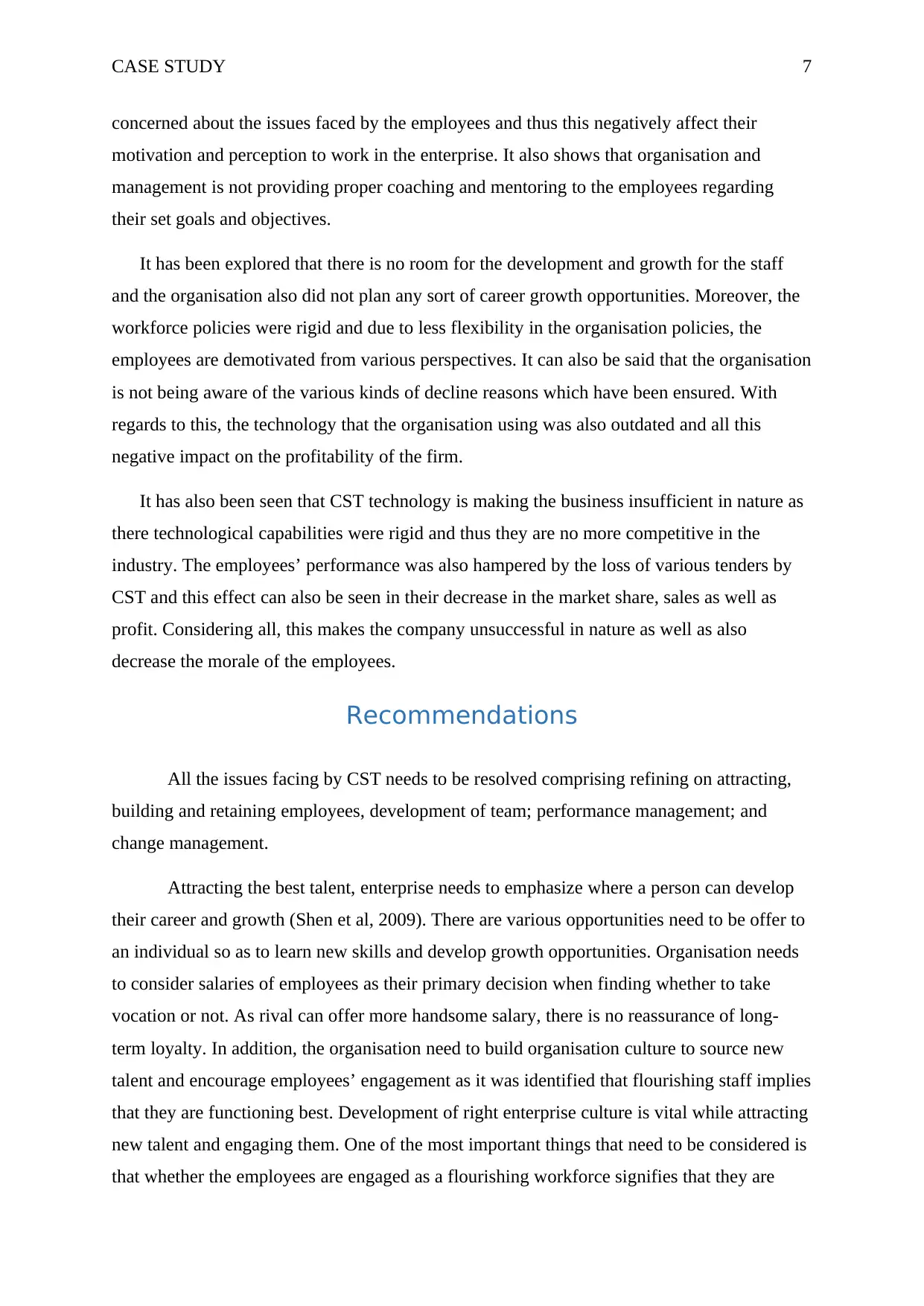
CASE STUDY 7
concerned about the issues faced by the employees and thus this negatively affect their
motivation and perception to work in the enterprise. It also shows that organisation and
management is not providing proper coaching and mentoring to the employees regarding
their set goals and objectives.
It has been explored that there is no room for the development and growth for the staff
and the organisation also did not plan any sort of career growth opportunities. Moreover, the
workforce policies were rigid and due to less flexibility in the organisation policies, the
employees are demotivated from various perspectives. It can also be said that the organisation
is not being aware of the various kinds of decline reasons which have been ensured. With
regards to this, the technology that the organisation using was also outdated and all this
negative impact on the profitability of the firm.
It has also been seen that CST technology is making the business insufficient in nature as
there technological capabilities were rigid and thus they are no more competitive in the
industry. The employees’ performance was also hampered by the loss of various tenders by
CST and this effect can also be seen in their decrease in the market share, sales as well as
profit. Considering all, this makes the company unsuccessful in nature as well as also
decrease the morale of the employees.
Recommendations
All the issues facing by CST needs to be resolved comprising refining on attracting,
building and retaining employees, development of team; performance management; and
change management.
Attracting the best talent, enterprise needs to emphasize where a person can develop
their career and growth (Shen et al, 2009). There are various opportunities need to be offer to
an individual so as to learn new skills and develop growth opportunities. Organisation needs
to consider salaries of employees as their primary decision when finding whether to take
vocation or not. As rival can offer more handsome salary, there is no reassurance of long-
term loyalty. In addition, the organisation need to build organisation culture to source new
talent and encourage employees’ engagement as it was identified that flourishing staff implies
that they are functioning best. Development of right enterprise culture is vital while attracting
new talent and engaging them. One of the most important things that need to be considered is
that whether the employees are engaged as a flourishing workforce signifies that they are
concerned about the issues faced by the employees and thus this negatively affect their
motivation and perception to work in the enterprise. It also shows that organisation and
management is not providing proper coaching and mentoring to the employees regarding
their set goals and objectives.
It has been explored that there is no room for the development and growth for the staff
and the organisation also did not plan any sort of career growth opportunities. Moreover, the
workforce policies were rigid and due to less flexibility in the organisation policies, the
employees are demotivated from various perspectives. It can also be said that the organisation
is not being aware of the various kinds of decline reasons which have been ensured. With
regards to this, the technology that the organisation using was also outdated and all this
negative impact on the profitability of the firm.
It has also been seen that CST technology is making the business insufficient in nature as
there technological capabilities were rigid and thus they are no more competitive in the
industry. The employees’ performance was also hampered by the loss of various tenders by
CST and this effect can also be seen in their decrease in the market share, sales as well as
profit. Considering all, this makes the company unsuccessful in nature as well as also
decrease the morale of the employees.
Recommendations
All the issues facing by CST needs to be resolved comprising refining on attracting,
building and retaining employees, development of team; performance management; and
change management.
Attracting the best talent, enterprise needs to emphasize where a person can develop
their career and growth (Shen et al, 2009). There are various opportunities need to be offer to
an individual so as to learn new skills and develop growth opportunities. Organisation needs
to consider salaries of employees as their primary decision when finding whether to take
vocation or not. As rival can offer more handsome salary, there is no reassurance of long-
term loyalty. In addition, the organisation need to build organisation culture to source new
talent and encourage employees’ engagement as it was identified that flourishing staff implies
that they are functioning best. Development of right enterprise culture is vital while attracting
new talent and engaging them. One of the most important things that need to be considered is
that whether the employees are engaged as a flourishing workforce signifies that they are
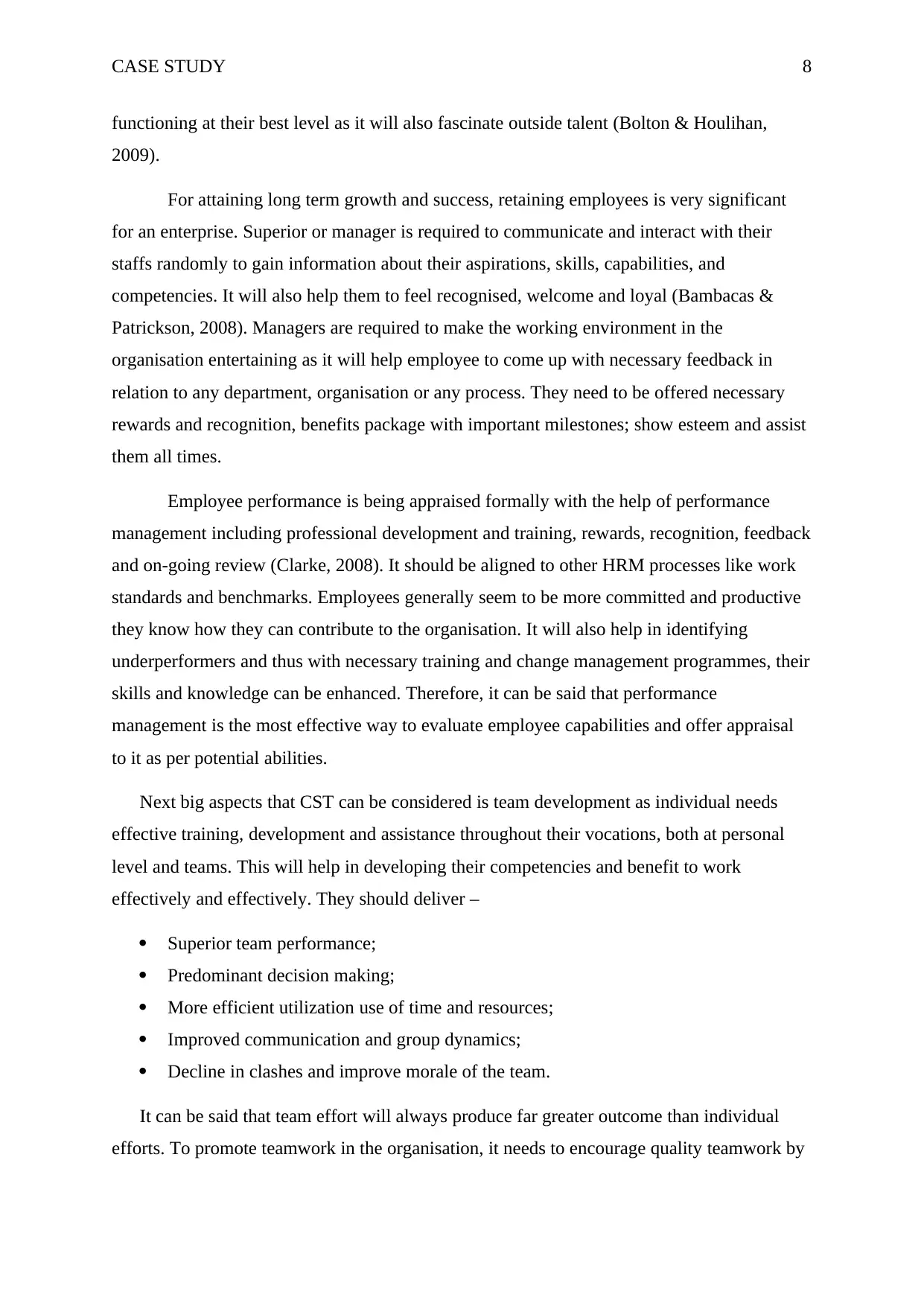
CASE STUDY 8
functioning at their best level as it will also fascinate outside talent (Bolton & Houlihan,
2009).
For attaining long term growth and success, retaining employees is very significant
for an enterprise. Superior or manager is required to communicate and interact with their
staffs randomly to gain information about their aspirations, skills, capabilities, and
competencies. It will also help them to feel recognised, welcome and loyal (Bambacas &
Patrickson, 2008). Managers are required to make the working environment in the
organisation entertaining as it will help employee to come up with necessary feedback in
relation to any department, organisation or any process. They need to be offered necessary
rewards and recognition, benefits package with important milestones; show esteem and assist
them all times.
Employee performance is being appraised formally with the help of performance
management including professional development and training, rewards, recognition, feedback
and on-going review (Clarke, 2008). It should be aligned to other HRM processes like work
standards and benchmarks. Employees generally seem to be more committed and productive
they know how they can contribute to the organisation. It will also help in identifying
underperformers and thus with necessary training and change management programmes, their
skills and knowledge can be enhanced. Therefore, it can be said that performance
management is the most effective way to evaluate employee capabilities and offer appraisal
to it as per potential abilities.
Next big aspects that CST can be considered is team development as individual needs
effective training, development and assistance throughout their vocations, both at personal
level and teams. This will help in developing their competencies and benefit to work
effectively and effectively. They should deliver –
Superior team performance;
Predominant decision making;
More efficient utilization use of time and resources;
Improved communication and group dynamics;
Decline in clashes and improve morale of the team.
It can be said that team effort will always produce far greater outcome than individual
efforts. To promote teamwork in the organisation, it needs to encourage quality teamwork by
functioning at their best level as it will also fascinate outside talent (Bolton & Houlihan,
2009).
For attaining long term growth and success, retaining employees is very significant
for an enterprise. Superior or manager is required to communicate and interact with their
staffs randomly to gain information about their aspirations, skills, capabilities, and
competencies. It will also help them to feel recognised, welcome and loyal (Bambacas &
Patrickson, 2008). Managers are required to make the working environment in the
organisation entertaining as it will help employee to come up with necessary feedback in
relation to any department, organisation or any process. They need to be offered necessary
rewards and recognition, benefits package with important milestones; show esteem and assist
them all times.
Employee performance is being appraised formally with the help of performance
management including professional development and training, rewards, recognition, feedback
and on-going review (Clarke, 2008). It should be aligned to other HRM processes like work
standards and benchmarks. Employees generally seem to be more committed and productive
they know how they can contribute to the organisation. It will also help in identifying
underperformers and thus with necessary training and change management programmes, their
skills and knowledge can be enhanced. Therefore, it can be said that performance
management is the most effective way to evaluate employee capabilities and offer appraisal
to it as per potential abilities.
Next big aspects that CST can be considered is team development as individual needs
effective training, development and assistance throughout their vocations, both at personal
level and teams. This will help in developing their competencies and benefit to work
effectively and effectively. They should deliver –
Superior team performance;
Predominant decision making;
More efficient utilization use of time and resources;
Improved communication and group dynamics;
Decline in clashes and improve morale of the team.
It can be said that team effort will always produce far greater outcome than individual
efforts. To promote teamwork in the organisation, it needs to encourage quality teamwork by
⊘ This is a preview!⊘
Do you want full access?
Subscribe today to unlock all pages.

Trusted by 1+ million students worldwide
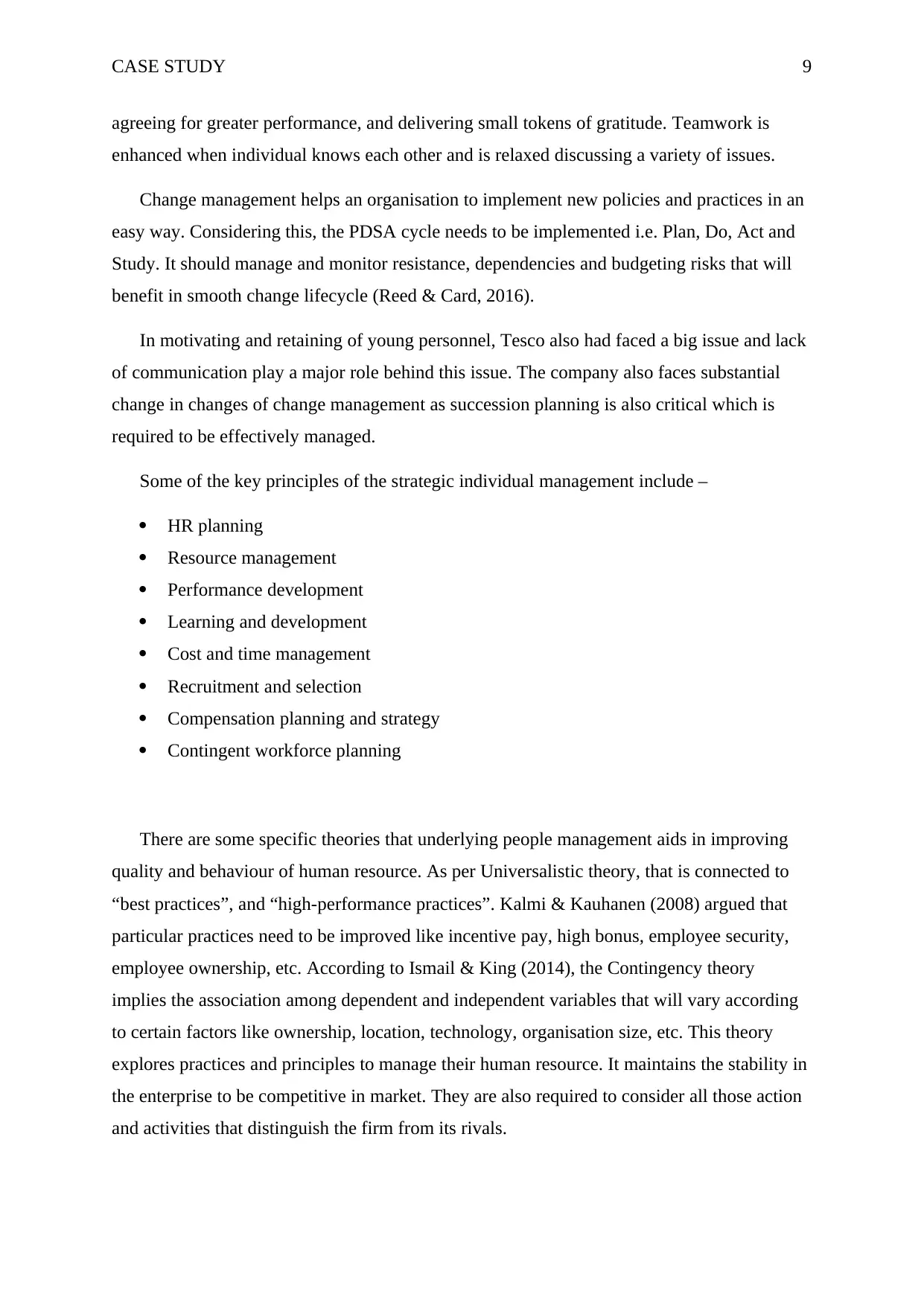
CASE STUDY 9
agreeing for greater performance, and delivering small tokens of gratitude. Teamwork is
enhanced when individual knows each other and is relaxed discussing a variety of issues.
Change management helps an organisation to implement new policies and practices in an
easy way. Considering this, the PDSA cycle needs to be implemented i.e. Plan, Do, Act and
Study. It should manage and monitor resistance, dependencies and budgeting risks that will
benefit in smooth change lifecycle (Reed & Card, 2016).
In motivating and retaining of young personnel, Tesco also had faced a big issue and lack
of communication play a major role behind this issue. The company also faces substantial
change in changes of change management as succession planning is also critical which is
required to be effectively managed.
Some of the key principles of the strategic individual management include –
HR planning
Resource management
Performance development
Learning and development
Cost and time management
Recruitment and selection
Compensation planning and strategy
Contingent workforce planning
There are some specific theories that underlying people management aids in improving
quality and behaviour of human resource. As per Universalistic theory, that is connected to
“best practices”, and “high-performance practices”. Kalmi & Kauhanen (2008) argued that
particular practices need to be improved like incentive pay, high bonus, employee security,
employee ownership, etc. According to Ismail & King (2014), the Contingency theory
implies the association among dependent and independent variables that will vary according
to certain factors like ownership, location, technology, organisation size, etc. This theory
explores practices and principles to manage their human resource. It maintains the stability in
the enterprise to be competitive in market. They are also required to consider all those action
and activities that distinguish the firm from its rivals.
agreeing for greater performance, and delivering small tokens of gratitude. Teamwork is
enhanced when individual knows each other and is relaxed discussing a variety of issues.
Change management helps an organisation to implement new policies and practices in an
easy way. Considering this, the PDSA cycle needs to be implemented i.e. Plan, Do, Act and
Study. It should manage and monitor resistance, dependencies and budgeting risks that will
benefit in smooth change lifecycle (Reed & Card, 2016).
In motivating and retaining of young personnel, Tesco also had faced a big issue and lack
of communication play a major role behind this issue. The company also faces substantial
change in changes of change management as succession planning is also critical which is
required to be effectively managed.
Some of the key principles of the strategic individual management include –
HR planning
Resource management
Performance development
Learning and development
Cost and time management
Recruitment and selection
Compensation planning and strategy
Contingent workforce planning
There are some specific theories that underlying people management aids in improving
quality and behaviour of human resource. As per Universalistic theory, that is connected to
“best practices”, and “high-performance practices”. Kalmi & Kauhanen (2008) argued that
particular practices need to be improved like incentive pay, high bonus, employee security,
employee ownership, etc. According to Ismail & King (2014), the Contingency theory
implies the association among dependent and independent variables that will vary according
to certain factors like ownership, location, technology, organisation size, etc. This theory
explores practices and principles to manage their human resource. It maintains the stability in
the enterprise to be competitive in market. They are also required to consider all those action
and activities that distinguish the firm from its rivals.
Paraphrase This Document
Need a fresh take? Get an instant paraphrase of this document with our AI Paraphraser
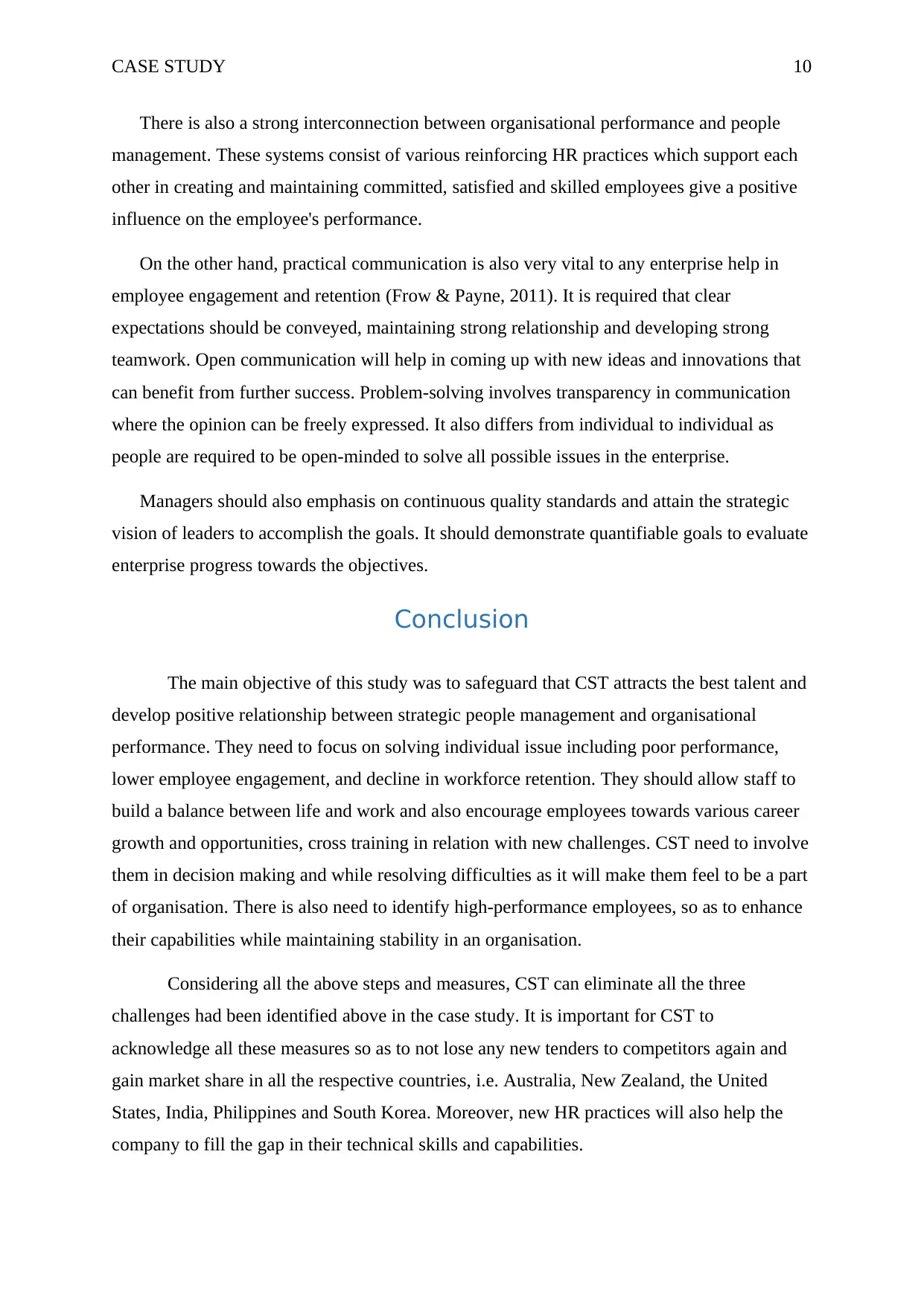
CASE STUDY 10
There is also a strong interconnection between organisational performance and people
management. These systems consist of various reinforcing HR practices which support each
other in creating and maintaining committed, satisfied and skilled employees give a positive
influence on the employee's performance.
On the other hand, practical communication is also very vital to any enterprise help in
employee engagement and retention (Frow & Payne, 2011). It is required that clear
expectations should be conveyed, maintaining strong relationship and developing strong
teamwork. Open communication will help in coming up with new ideas and innovations that
can benefit from further success. Problem-solving involves transparency in communication
where the opinion can be freely expressed. It also differs from individual to individual as
people are required to be open-minded to solve all possible issues in the enterprise.
Managers should also emphasis on continuous quality standards and attain the strategic
vision of leaders to accomplish the goals. It should demonstrate quantifiable goals to evaluate
enterprise progress towards the objectives.
Conclusion
The main objective of this study was to safeguard that CST attracts the best talent and
develop positive relationship between strategic people management and organisational
performance. They need to focus on solving individual issue including poor performance,
lower employee engagement, and decline in workforce retention. They should allow staff to
build a balance between life and work and also encourage employees towards various career
growth and opportunities, cross training in relation with new challenges. CST need to involve
them in decision making and while resolving difficulties as it will make them feel to be a part
of organisation. There is also need to identify high-performance employees, so as to enhance
their capabilities while maintaining stability in an organisation.
Considering all the above steps and measures, CST can eliminate all the three
challenges had been identified above in the case study. It is important for CST to
acknowledge all these measures so as to not lose any new tenders to competitors again and
gain market share in all the respective countries, i.e. Australia, New Zealand, the United
States, India, Philippines and South Korea. Moreover, new HR practices will also help the
company to fill the gap in their technical skills and capabilities.
There is also a strong interconnection between organisational performance and people
management. These systems consist of various reinforcing HR practices which support each
other in creating and maintaining committed, satisfied and skilled employees give a positive
influence on the employee's performance.
On the other hand, practical communication is also very vital to any enterprise help in
employee engagement and retention (Frow & Payne, 2011). It is required that clear
expectations should be conveyed, maintaining strong relationship and developing strong
teamwork. Open communication will help in coming up with new ideas and innovations that
can benefit from further success. Problem-solving involves transparency in communication
where the opinion can be freely expressed. It also differs from individual to individual as
people are required to be open-minded to solve all possible issues in the enterprise.
Managers should also emphasis on continuous quality standards and attain the strategic
vision of leaders to accomplish the goals. It should demonstrate quantifiable goals to evaluate
enterprise progress towards the objectives.
Conclusion
The main objective of this study was to safeguard that CST attracts the best talent and
develop positive relationship between strategic people management and organisational
performance. They need to focus on solving individual issue including poor performance,
lower employee engagement, and decline in workforce retention. They should allow staff to
build a balance between life and work and also encourage employees towards various career
growth and opportunities, cross training in relation with new challenges. CST need to involve
them in decision making and while resolving difficulties as it will make them feel to be a part
of organisation. There is also need to identify high-performance employees, so as to enhance
their capabilities while maintaining stability in an organisation.
Considering all the above steps and measures, CST can eliminate all the three
challenges had been identified above in the case study. It is important for CST to
acknowledge all these measures so as to not lose any new tenders to competitors again and
gain market share in all the respective countries, i.e. Australia, New Zealand, the United
States, India, Philippines and South Korea. Moreover, new HR practices will also help the
company to fill the gap in their technical skills and capabilities.

CASE STUDY 11
⊘ This is a preview!⊘
Do you want full access?
Subscribe today to unlock all pages.

Trusted by 1+ million students worldwide
1 out of 15
Related Documents
Your All-in-One AI-Powered Toolkit for Academic Success.
+13062052269
info@desklib.com
Available 24*7 on WhatsApp / Email
![[object Object]](/_next/static/media/star-bottom.7253800d.svg)
Unlock your academic potential
Copyright © 2020–2025 A2Z Services. All Rights Reserved. Developed and managed by ZUCOL.




